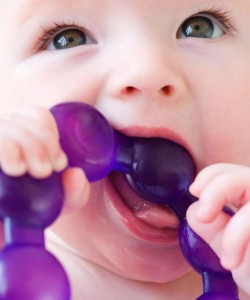Caring for Baby’s Gums
You can start caring for baby’s gums right away. But at first, the care won’t involve a toothbrush and toothpaste. Instead, take these steps:
- Get a soft, moistened washcloth or piece of gauze.
- Gently wipe down your baby’s gums at least twice a day.
- Especially wipe your baby’s gums after feedings and before bedtime.
This will wash off bacteria and prevent them from clinging to gums. Bacteria can leave behind a sticky plaque that damages infant teeth as they come in.
Brushing Baby’s Teeth
When the first baby teeth start to pop up, you can graduate to a toothbrush. Choose one with a:
- soft brush
- small head
- large handle
At first, just wet the toothbrush. As soon as teeth erupt, you can start using toothpaste in the amount of a grain of rice. You can increase this to a pea-sized amount of fluoride toothpaste when your child is age 3. Brush gently all around your child’s baby teeth — front and back.
You should brush your baby’s teeth until he or she is old enough to hold the brush. Continue to supervise the process until your child can rinse and spit without assistance. That usually happens at around age 6.
Keep on the lookout for any signs of baby tooth decay — brown or white spots or pits on the teeth.
Teething
It can take two years before all of the infant teeth have made their way through your baby’s gums. The process as each tooth emerges is called “teething.”
Teething is uncomfortable. That’s why your baby cries and fusses in the days or weeks before each baby tooth pops up. Babies can display other teething symptoms, too, including:
- drooling
- swollen gums
Here are a few tips to relieve your baby’s teething pain:
Teething rings. Let your baby chew on a clean, cool teething ring or cold washcloth. Just avoid giving your child anything that is small enough to choke on. Also avoid a teething ring with liquid inside that could break open.
Gum rubbing. Rub your baby’s gums with a clean finger.




